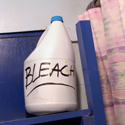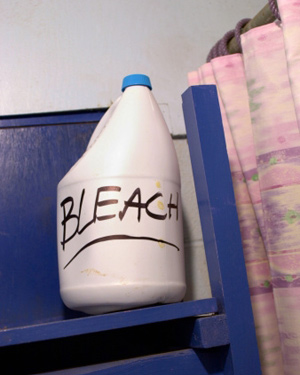
20 Feb The “Miracle” Bleach Cure & Bleach Baths

The New York Times published an article on a medical breakthrough for a type of fatal skin infection called necrotizing fasciitis, aka, "Flesh-eating bacteria". The secret ingredient? Purified diluted bleach.
The “Miracle” Bleach Cure
Sometimes the stars align and the universe continually puts things in front of you until you take notice. Over the past few months patients have been raving about a new product they’ve bought from veterinarians and equestrian outlets. This miracle product “kills everything” they say. Marketed for uncomplicated skin infections, this product promotes a cure for well…just about everything. Got ringworm? Sores? Abscesses? Skin Rot? Then this $35 a bottle product is for you! (It is not hard to imagine the old Patent Medicine Salesman circa 1900 barking out the same promises to a local rubes). What is this miracle product you ask? I actually chuckled out loud when I read it: Diluted bleach.
A day or two after investigating this, the New York Times published an article on a medical breakthrough for a type of fatal skin infection called necrotizing fasciitis, aka, "Flesh-eating bacteria". The secret ingredient? Purified diluted bleach. The researchers noted that not only did their solution kill the bacteria but it broke down the bacterial toxins that dissolve human skin and allow the infection to run wild. If the veterinary diluted bleach is selling for $35 a bottle, I shudder to imagine what they are going to try charging for this version.
Right around the same time, Stanford University published a truly amazing study on how diluted bleach can be used to potentially treat eczema and skin damaged from radiation treatments. Dermatologists have been recommending bleach baths for eczema increasingly over the last decade. It is not a cure for eczema but seems to help manage the level of inflammation and itching in the skin. I was taught, and subsequently repeated, the theory that it decreased the bacterial count on the skin. People usually look at me a little skeptically when I suggest it. But the Stanford authors noted that the concentration of bleach we recommend for our eczema patients were not strong enough to actually kill bacteria on the skin. They discovered it actually blocked a key component for inflammation inside the skin cells that keeps eczema from spirally out of control. This also explains why it seems to work for radiation induced skin pain, which is not a bacterial overgrowth problem. It turns out that dermatologists across the world were prescribing the right thing, but for the wrong reasons.

If you do bleach baths for eczema, dilute the bleach accordingly, and do not do them more than twice weekly.
The Bleach Bath
So how does one go about preparing a bleach bath? I recommend adding ¼- ½ cup of household bleach to your bath water in a standard 40 gallon tub. Dilute accordingly to whatever level you fill the tub. This is not an exact science, so do your best guestimate. Grab a book and soak for about 10 minutes while keeping your hair and face out of the bleach water. If you have gone to the trouble to do all this already, I want to impose upon you to use a fragrance free moisturizer immediately after patting your skin dry. Keep in mind, these bleach baths help minimize inflammation. The jury is still out on how much exactly they decrease bacteria counts. Do not do them more than twice weekly. If you have continued trouble with dry skin, or it worsens, adjust the amount of bleach and/or your exposure time. Try to avoid any soaps or cleansers while in this bath. If you are dirty, take a shower instead. As bizarre as soaking in a cauldron of diluted bleach sounds, a swimming pool is essentially the same thing. Bleachbath.net is a good resource to learn more on this (and to prove to you I am not completely mad).
But the miracles of diluted bleach don’t seem to stop here. The Stanford study also took older laboratory mice and "by bathing them in the bleach solution, the animals’ skin began to look younger. It went from old and fragile to thicker." The researchers plan on starting human trials soon and investigating how diabetic ulcers respond. If you listen closely, you can hear the price of bleach going up around the globe.
Be Safe
Time for a quick reality check. The anti-aging effects were noted on microscopic examination and not visible with the naked eye. Household bleach available from the supermarket is highly corrosive to the lungs, eyes, and skin in the available concentrations. The authors of these studies all methodically diluted bleach to very weak concentrations. We do not need our Northern California emergency rooms flooded with bleach-induced burns and ulcerations. This is not an example of "If a little bit is good, a lot is better".

